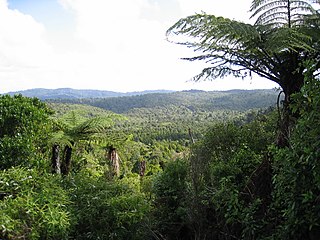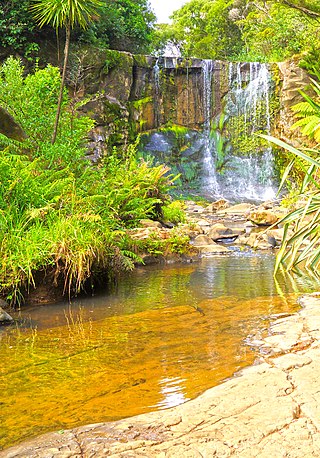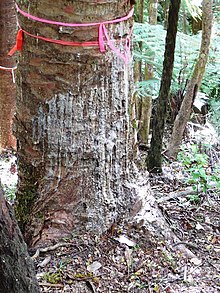
Agathis australis, commonly known by its Māori name kauri, is a coniferous tree in the family Araucariaceae, found north of 38°S in the northern regions of New Zealand's North Island.

Phytophthora is a genus of plant-damaging oomycetes, whose member species are capable of causing enormous economic losses on crops worldwide, as well as environmental damage in natural ecosystems. The cell wall of Phytophthora is made up of cellulose. The genus was first described by Heinrich Anton de Bary in 1875. Approximately 210 species have been described, although 100–500 undiscovered Phytophthora species are estimated to exist.

Waipoua Forest is a forest, on the west coast of the Northland Region of New Zealand's North Island. It preserves some of the best examples of kauri forest remaining in New Zealand. It is notable for having two of the largest living kauri trees, Tāne Mahuta and Te Matua Ngahere.

Phytophthora ramorum is the oomycete plant pathogen known to cause the disease sudden oak death (SOD). The disease kills oak and other species of trees and has had devastating effects on the oak populations in California and Oregon, as well as being present in Europe. Symptoms include bleeding cankers on the tree's trunk and dieback of the foliage, in many cases leading to the death of the tree.

The Waitākere Ranges is a mountain range in New Zealand. Located in West Auckland between metropolitan Auckland and the Tasman Sea, the ranges and its foothills and coasts comprise some 27,720 hectares of public and private land. The area, traditionally known to Māori as Te Wao Nui o Tiriwa, is of local, regional, and national significance. The Waitākere Ranges includes a chain of hills in the Auckland Region, generally running approximately 25 kilometres (16 mi) from north to south, 25 km west of central Auckland. The ranges are part of the Waitākere Ranges Regional Park.

The Hunua Ranges is a mountain range and regional park to the southeast of Auckland city, in the Auckland and Waikato regions of New Zealand's North Island. The ranges cover some 250 square kilometres (97 sq mi) and rise to 688 metres (2255 ft) at Kohukohunui.

Tāne Mahuta, also called "God of the Forest", is a giant kauri tree in the Waipoua Forest of Northland Region, New Zealand. Its age is unknown but is estimated to be between 1,250 and 2,500 years. It is the largest living kauri tree known to stand today. It is named for Tāne, the Māori god of forests and of birds.

Phytophthora cinnamomi, also known as cinnamon fungus, is a soil-borne water mould that produces an infection which causes a condition in plants variously called "dieback", "root rot", or, "ink disease".

Scenic Drive is a road that runs through the bush-clad Waitākere Ranges from Titirangi to Swanson on the western outskirts of Auckland, New Zealand. It is part of Auckland urban route 24. As the name indicates, it is famous for the sweeping views over the western parts of the Auckland Region.

Kitekite Falls is a scenic 3-tiered waterfall near Auckland, New Zealand. The falls drop a total of 40 metres (130 ft). From the lookout on Kitekite track the falls appear even higher because there is white water running over rocks into a small pool from the upper swimming hole, then falling down into a large pool, then falling to a small pool before beginning an almost vertical descent in the final 3-tiers, making the total height closer to 80 metres (260 ft). They are located on the Glen Esk Stream near Piha Beach.

Te Kawerau ā Maki, Te Kawerau a Maki, or Te Kawerau-a-Maki is a Māori iwi (tribe) of the Auckland Region of New Zealand. Predominantly based in West Auckland, it had 251 registered adult members as of June 2017. The iwi holds land for a new marae and papakāinga at Te Henga that was returned in 2018; and land for a secondary marae at Te Onekiritea that was returned in 2015. it has no wharenui yet.

Phytophthora kernoviae is a plant pathogen that mainly infects European beech and Rhododendron ponticum. It was first identified in 2003 in Cornwall, UK when scientists were surveying for the presence of Phytophthora ramorum. This made it the third new Phytophthora species to be found in the UK in a decade. It was named Phytophthora kernoviae after the ancient name for Cornwall, Kernow. It causes large stem lesions on beech and necrosis of stems and leaves of Rhododendron ponticum. It is self-fertile. It has also been isolated from Quercus robur and Liriodendron tulipifera. The original paper describing the species, stated it can infect Magnolia and Camellia species, Pieris formosa, Gevuina avellana, Michelia doltsopa and Quercus ilex. Since then many other plants have been identified as natural hosts of the pathogen. Molecular analysis has revealed that an infection on Pinus radiata, recorded in New Zealand in 1950, was caused by P. kernoviae. The pathogen was also noted on Drimys winteri, Gevuina avellana, Ilex aquifolium, Quercus ilex, Vaccinium myrtillus, Hedera helix, Podocarpus salignas.
Biosecurity in New Zealand guards against threats to agriculture and biodiversity, with strict border control measures being taken to prevent unwanted organisms from entering the country. New Zealand is an island nation that is geographically isolated from any other significant landmass. The species that are present evolved in the absence of organisms from elsewhere and display a high degree of endemism. Notable is the lack of land-based mammals, except for two species of bat. Indigenous species are at risk from population decline or extinction if any invasive species are introduced.
Ross Ewen Beever was a New Zealand geneticist and mycologist.

Rosemary E. Bradshaw is a New Zealand mycologist, as of 2019 full professor of genetics at the Massey University.

Aotea Conservation Park is a 12,300 hectare protected area on Great Barrier Island in New Zealand's Hauraki Gulf. It was established in 2015, and comprises 43 percent of the island.

Mokoroa Falls is a waterfall located between Muriwai and the Waitākere Ranges in Auckland's west coast in New Zealand. It is located in the Goldie Bush Scenic Reserve.

The Goldie Bush Scenic Reserve, also known as Goldies Bush and Te Taiapa, is a forested area of West Auckland, New Zealand. Located south-east of Muriwai, the reserve is home to the Mokoroa Falls.

Arataki Visitor Centre is a tourism and education centre in West Auckland, New Zealand, often described as the gateway to the Waitākere Ranges. The centre provides information about the Waitākere Ranges, and organises educational events.

Amanda Black is a New Zealand soil chemist who as of 2023 is a full professor at Lincoln University, specialising in soil health and biosecurity. She has worked on kauri dieback and integration of matauranga Māori into science.























